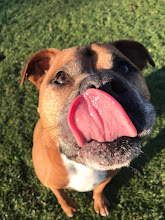Every time your dog shows aggression, it’s an opportunity for you to correct the problem, don’t avoid it - cure it!
When he ‘shows out’ to another dog, handle him into a sit next you, the dogs shoulder should be roughly level with you leg and he MUST NOT put his paw in front of your foot, on your foot, lean against you or sit crooked; he will know how important this is and will try really hard to stay in front of you or sit anywhere apart from where you want him to.
Practice heelwork. The traditional side for walking a dog is on the left; so all instruction assume the dog is on your left side; Again the approach should be, when you take your dog out, you take your dog train him, not to take him for a walk.
The type of collar that you use on you dog can also have an impact on how your dog responds. We are happy to use a full check. Not everyone agrees with this, however, if used correctly, especially with anti-social dogs, I believe a full check to be a very good training aid. ½ Checks are OK but a normal collar doesn’t seem to work very well. When used correctly a full check should be loose all of the
time unless the dog does something wrong; then a quick tug and let loose again. To practice the heelwork, begin with the dog in a sit and lead in you right hand and loose to the dogs neck; as you move forward the dog will probably pull forward. This puts him in front of the pack. If you can turn right before the lead goes tight and add the ‘tug’ two thing happen
1 You go to the front of the pack
2 You correct your dog effectively
The dog will probably try and go in front again; if it goes past you, turn right and correct. I don’t use any encouragement to try and get the dog to walk next to me, if he’s wide or in front, I just correct him and change direction and add praise ONLY when it walks close to my left leg.
Another way of stopping the dog from pulling – begin the same way but this time when the dog pulls in front ; Transfer the lead to your left hand and walk backwards. Correct the dog with gentle tugs on the lead and growling ‘bad dog’ or ‘no’. This should be a quiet correction, no shouting. When the dogs head gets level with your left leg walk forwards and praise your dog. Let the lead go loose and if the dog goes past you repeat the walking backwards.
These methods will both help correct the dog for being in front (pack leader) and praise the dog for being part of your pack (submissive) – This works really well if the dog is just pulling or showing out against another dog.
Don’t try and stop him from looking at the other dogs; it’s a natural thing for them to do, so let him do it, just make sure he sits next to you or walks next to you while he’s doing it. You will find the more your dog works for you the less he will stare at the other dogs and the more his attention will turn to you. He will also become more relaxed because you have taken the pressure away from him.
If you can find some willing play mates, off the lead is better. I always use muzzles in the class but some of the handlers are happy for their dogs to be out of a muzzle when taking them out; you know your dog, so if it needs one why not use one? A lot of our handlers now prefer to keep their dog in a muzzle, it gives them more confidence, and make it much easier to teach your dog to relax.



